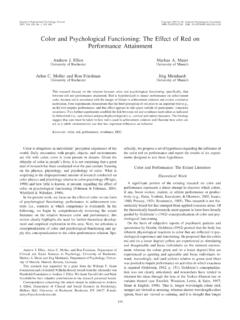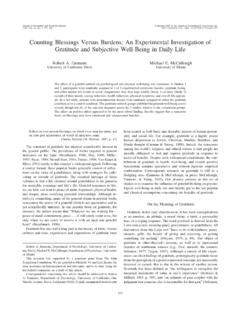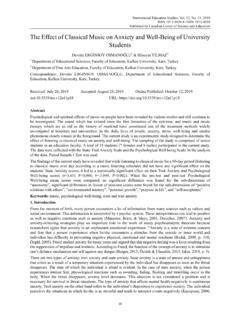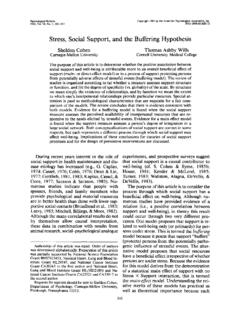Transcription of Report of the APA Task Force on the Sexualization of Girls
1 Report of the APA Task Force on the Sexualization of Girls Executive Summary APA Task Force on the Sexualization of Girls Members Eileen L. Zurbriggen, PhD (Chair). Rebecca L. Collins, PhD. Sharon Lamb, EdD. Tomi-Ann Roberts, PhD. Deborah L. Tolman, EdD. L. Monique Ward, PhD. Jeanne Blake (Public Member). Printed single copies available from: American psychological Association Public Interest Directorate Women's Programs 750 First Street, NE. Washington, DC 20002-4242. (202-336-6044). Available online at Copyright 2007 by the American psychological material may be reproduced in whole or in part without fees or permission, provided that acknowledgment is given to the American psychological material may not be reprinted, translated, or distributed electronically without prior permission in writing from the publisher. For permission, contact APA, Rights and Permissions, 750 First Street, NE,Washington, DC 20002-4242. Report of the APA Task Force on the Sexualization of Girls : Executive Summary examines the prevalence and provides examples of Report of the Task Force on Sexualization in society and in cultural institutions, as the Sexualization of Girls well as interpersonally and intrapsychically; (c) evaluates the evidence suggesting that Sexualization has negative Executive Summary consequences for Girls and for the rest of society; and (d) describes positive alternatives that may help counteract J ournalists, child advocacy organizations, parents, and psychologists have argued that the Sexualization of Girls is a broad and increasing problem and is harmful to the influence of Sexualization .
2 There are several components to Sexualization , and APA Task Force on the Sexualization of Girls was formed these set it apart from healthy sexuality. Sexualization in response to these expressions of public concern. occurs when APA has long been involved in issues related to the a person's value comes only from his or her impact of media content on children. In 1994, APA sexual appeal or behavior, to the exclusion of adopted a policy resolution on Violence in Mass Media, other characteristics;. which updated and expanded an earlier resolution on a person is held to a standard that equates physical televised violence. In 2004, the APA Task Force on attractiveness (narrowly defined) with being sexy;. Advertising and Children produced a Report examining a person is sexually objectified that is, made into a broad issues related to advertising to Report thing for others' sexual use, rather than seen as a provided recommendations to restrict advertising that is person with the capacity for independent action and primarily directed at young children and to include decision making; and/or developmentally appropriate disclaimers in advertising, sexuality is inappropriately imposed upon a person.
3 As well as recommendations regarding research, All four conditions need not be present; any one is applied psychology, industry practices, media literacy, an indication of fourth condition (the advertising, and schools. In 2005, APA adopted the inappropriate imposition of sexuality) is especially relevant policy resolution on Violence in Video Games and to children. Anyone ( Girls , boys, men, women) can be sexu- Interactive Media, which documented the negative alized. But when children are imbued with adult sexuality, impact of exposure to violent interactive media on it is often imposed upon them rather than chosen by them. children and youth and called for the reduction of Self-motivated sexual exploration, on the other hand, is not violence in these resolutions and reports Sexualization by our definition, nor is age-appropriate addressed how violent media and advertising affect exposure to information about sexuality. children and youth, but they did not address Sexualization .
4 The APA Task Force on the Sexualization of Girls was Evidence for the Sexualization tasked with examining the psychological theory, research, of Girls and clinical experience addressing the Sexualization of Girls via media and other cultural messages, including the prevalence of these messages and their impact on Girls and the role and impact of race/ethnicity and socioeconomic V irtually every media form studied provides ample evidence of the Sexualization of women, including television, music videos, music lyrics, movies, magazines, task Force was charged with producing a Report , sports media, video games, the Internet, and advertising ( , including recommendations for research, practice, educa- Gow, 1996; Grauerholz & King, 1997; Krassas, Blauwkamp, &. tion and training, policy, and public awareness. Wesselink, 2001, 2003; Lin, 1997; Plous & Neptune, 1997;. Vincent, 1989;Ward, 1995). Some studies have examined This Report examines and summarizes psychological forms of media that are especially popular with children and theory, research, and clinical experience addressing the sex- adolescents, such as video games and teen-focused magazines.
5 Ualization of Report (a) defines Sexualization ; (b). 1. Report of the APA Task Force on the Sexualization of Girls : Executive Summary In study after study, findings have indicated that women Girls . Some may allow or encourage plastic surgery to help more often than men are portrayed in a sexual manner ( , Girls meet that goal. Research shows that teachers sometimes dressed in revealing clothing, with bodily postures or facial encourage Girls to play at being sexualized adult women expressions that imply sexual readiness) and are objectified (Martin, 1988) or hold beliefs that Girls of color are ( , used as a decorative object, or as body parts rather than hypersexual and thus unlikely to achieve academic success a whole person). In addition, a narrow (and unrealistic) (Rol n-Dow, 2004). Both male and female peers have been standard of physical beauty is heavily are found to contribute to the Sexualization of Girls Girls by the models of femininity presented for young Girls to study policing each other to ensure conformance with standards and emulate.
6 Of thinness and sexiness (Eder, 1995; Nichter, 2000) and boys by sexually objectifying and harassing Girls . Finally, at In some studies, the focus was on the Sexualization of the extreme end, parents, teachers, and peers, as well as female characters across all ages, but most focused specifically others ( , other family members, coaches, or strangers). on young adult few studies examined the sometimes sexually abuse, assault, prostitute, or traffic Girls , prevalence of sexualized portrayals of Girls in particular, those a most destructive form of Sexualization . that have been conducted found that such Sexualization does occur and may be increasingly common. For example, If Girls purchase (or ask their parents to purchase). O'Donohue, Gold, and McKay (1997) coded advertisements products and clothes designed to make them look physically over a 40-year period in five magazines targeted to men, appealing and sexy, and if they style their identities after the women, or a general adult relatively sexy celebrities who populate their cultural landscape, they few ( ) of the ads portrayed children in a sexualized are, in effect , sexualizing themselves.
7 Girls also sexualize manner, of those that did, 85% sexualized Girls rather than themselves when they think of themselves in objectified boys. Furthermore, the percentage of sexualizing ads terms. psychological researchers have identified self-objectifica- increased over time. tion as a key process whereby Girls learn to think of and treat their own bodies as objects of others' desires Although extensive analyses documenting the (Frederickson & Roberts, 1997; McKinley & Hyde, 1996). Sexualization of Girls , in particular, have yet to be conducted, In self-objectification, Girls internalize an observer's individual examples can easily be include perspective on their physical selves and learn to treat advertisements ( , the Skechers naughty and nice ad that themselves as objects to be looked at and evaluated for their featured Christina Aguilera dressed as a schoolgirl in pigtails, appearance. Numerous studies have documented the presence with her shirt unbuttoned, licking a lollipop), dolls ( , Bratz of self-objectification in women more than in men.)
8 Dolls dressed in sexualized clothing such as miniskirts, fishnet Several studies have also documented this phenomenon stockings, and feather boas), clothing (thongs sized for 7 to in adolescent and preadolescent Girls (McConnell, 2001;. 10-year-olds, some printed with slogans such as wink Slater & Tiggemann, 2002). wink ), and television programs ( , a televised fashion show in which adult models in lingerie were presented as young Girls ). Research documenting the pervasiveness and Consequences of the Sexualization influence of such products and portrayals is sorely needed. of Girls Societal messages that contribute to the Sexualization of Girls come not only from media and merchandise but also through Girls ' interpersonal relationships ( , with parents, P sychology offers several theories to explain how the Sexualization of Girls and women could influence Girls ' well-being. Ample evidence testing these theories teachers, and peers; Brown & Gilligan, 1992).
9 Parents may indicates that Sexualization has negative effects in a contribute to Sexualization in a number of ways. For variety of domains, including cognitive functioning, physi- example, parents may convey the message that maintaining an cal and mental health, sexuality, and attitudes and beliefs. attractive physical appearance is the most important goal for 2. Report of the APA Task Force on the Sexualization of Girls : Executive Summary Although most of these studies have been conducted on row representations of female beauty ( , the thin ideal ). women in late adolescence ( , college age), findings are and disordered eating attitudes and symptoms. Research likely to generalize to younger adolescents and to Girls , also links exposure to sexualized female ideals with lower who may be even more strongly affected because their self-esteem, negative mood, and depressive symptoms sense of self is still being formed. among adolescent Girls and women.
10 In addition to mental health consequences of Sexualization , research suggests that Cognitive and Emotional Consequences Girls ' and women's physical health may also be negatively affected, albeit indirectly. Cognitively, self-objectification has been repeatedly shown to detract from the ability to concentrate and focus one's attention, thus leading to impaired performance on mental Sexuality activities such as mathematical computations or logical Sexual well-being is an important part of healthy reasoning (Frederickson, Roberts, Noll, Quinn, & Twenge, development and overall well-being, yet evidence suggests 1998; Gapinski, Brownell, & LaFrance, 2003; Hebl, King, & that the Sexualization of Girls has negative consequences Lin, 2004). One study demonstrated this fragmenting quite in terms of Girls ' ability to develop healthy sexuality. vividly (Fredrickson et al., 1998).While alone in a dressing Self-objectification has been linked directly with dimin- room, college students were asked to try on and evaluate ished sexual health among adolescent Girls ( , as meas- either a swimsuit or a they waited for 10 ured by decreased condom use and diminished sexual minutes wearing the garment, they completed a math test.)


















